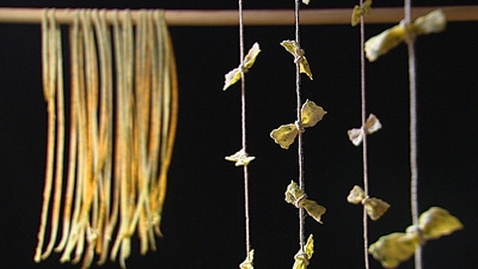Pasta Making
Ingredients
- 200 g “00” flour (or preferably 100g “00” flour and 100g semolina flour)
- pinch of salt
- 2 eggs
- 15 ml olive oil
- variation - herb pasta
- nb: blend all the other ingredients before mixing with the flour
- pinch of salt
- 2 medium eggs
- 3 tblsp chopped fresh herbs
- 1 tblsp olive oil
- 200 g strong white flour
Method
- This is the
traditional method of making pasta. You sift the flour and salt onto a
clean work surface and make a well in the centre with your fist. Beat
the eggs and oil together and pour into the well. Gradually mix the
liquid ingredients into the flour, using the fingers of one hand. Knead
the pasta until it is smooth. Wrap it in cling film and allow it to rest
for at least thirty minutes before attempting to roll out. It will make
the pasta will be much more elastic.
- If you prefer to use a
food processor, you start by sifting the flour and salt into the bowl.
Pour in the beaten eggs and oil, together with any flavourings and
process until the dough begins to come together. Turn out and knead
until smooth. Wrap in cling film and rest for at least thirty minutes.
- Rolling out using a Pasta Machine
- Feed the rested dough
through the widest setting several times and then pass the pasta through
the machine, narrowing the setting by one notch each time, until the
required thickness is reached. Generally the second from last setting is
best for tagliatelle and the finest setting is used for ravioli or
other pasta that is to be filled. Once the required thickness is
reached, hang the pasta over a piece of dowelling or a clean broom
handle to dry a little. This will make cutting easier as the pasta won’t
be as sticky, although if you are making stuffed pasta, drying isn’t
necessary because it needs to be slightly sticky to adhere properly.
- Fit the appropriate
cutters to the machine. Pass the pasta through, then transfer to a tray
covered with a lightly dusting of flour. Toss the pasta lightly in the
flour or drape the pasta over the dowelling or broom handle again
allowing it to dry a little until ready to cook.
- Rolling out by hand:
- On a clean, but not
floured, surface, roll out one third of the dough to a 5mm (1/4 inch)
thickness. Lift the dough from the surface and rotate 45o. The dough
should cling, but not stick, to the surface. This helps in the
stretching process. Continue rolling, lifting and rotating until the
dough is very thin. Repeat with remaining dough.
- To cook the pasta
- As a guide, you will
need four litres, or seven pints, of water and 45ml (3 tbsp) of salt to
every 350-450g (12 oz-1lb) of pasta. A tablespoon of olive oil will help
to stop the water boil over and prevent the pasta sticking but if you
have enough water in the pan and you stir the pasta as it goes in, it
will not stick anyway. Add the pasta to a large pan of boiling salted
water and stir once to prevent sticking. Do not cover the pan, or the
water will boil over.
- Quickly bring the
pasta back to a rolling boil, stir once and boil until al dente,
literally translated ‘to the tooth.’ The pasta should be just firm to
the bite; it should not have a hard centre, nor should it be very
floppy. Calculate the cooking time from the moment the pasta starts to
boil again.
- Fresh unfilled pasta
such as spaghetti and tagliatelle, it usually takes two to three minutes
to cook. But note that very thin pasta can be ready almost as soon as
the water returns to the boil. For fresh filled pasta, such as ravioli,
and tortellini, allow five to ten minutes.
- Quickly drain the
pasta well using a large colander or sieve. Hold back 30-45ml (2-3 tbsp)
of the cooking water because this will help the sauce to cling to the
pasta. Dress the pasta immediately with the sauce, oil or butter and
serve hot pasta straight away. It is up to you whether you toss the
sauce before serving or serve it piled on top of the pasta. Either way,
the pasta should be tossed with the sauce before eating.

No comments:
Post a Comment